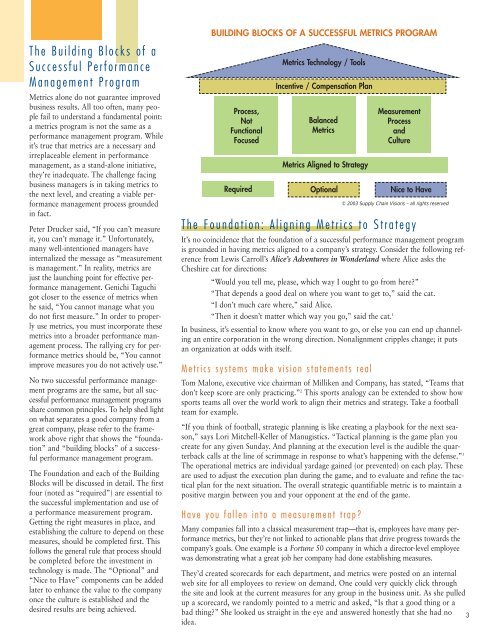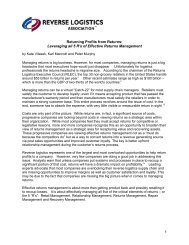is your metrics program measuring up? - Supply Chain Visions
is your metrics program measuring up? - Supply Chain Visions
is your metrics program measuring up? - Supply Chain Visions
Create successful ePaper yourself
Turn your PDF publications into a flip-book with our unique Google optimized e-Paper software.
The Building Blocks of a<br />
Successful Performance<br />
Management Program<br />
Metrics alone do not guarantee improved<br />
business results. All too often, many people<br />
fail to understand a fundamental point:<br />
a <strong>metrics</strong> <strong>program</strong> <strong>is</strong> not the same as a<br />
performance management <strong>program</strong>. While<br />
it’s true that <strong>metrics</strong> are a necessary and<br />
irreplaceable element in performance<br />
management, as a stand-alone initiative,<br />
they’re inadequate. The challenge facing<br />
business managers <strong>is</strong> in taking <strong>metrics</strong> to<br />
the next level, and creating a viable performance<br />
management process grounded<br />
in fact.<br />
Peter Drucker said, “If you can’t measure<br />
it, you can’t manage it.” Unfortunately,<br />
many well-intentioned managers have<br />
internalized the message as “measurement<br />
<strong>is</strong> management.” In reality, <strong>metrics</strong> are<br />
just the launching point for effective performance<br />
management. Genichi Taguchi<br />
got closer to the essence of <strong>metrics</strong> when<br />
he said, “You cannot manage what you<br />
do not first measure.” In order to properly<br />
use <strong>metrics</strong>, you must incorporate these<br />
<strong>metrics</strong> into a broader performance management<br />
process. The rallying cry for performance<br />
<strong>metrics</strong> should be, “You cannot<br />
improve measures you do not actively use.”<br />
No two successful performance management<br />
<strong>program</strong>s are the same, but all successful<br />
performance management <strong>program</strong>s<br />
share common principles. To help shed light<br />
on what separates a good company from a<br />
great company, please refer to the framework<br />
above right that shows the “foundation”<br />
and “building blocks” of a successful<br />
performance management <strong>program</strong>.<br />
The Foundation and each of the Building<br />
Blocks will be d<strong>is</strong>cussed in detail. The first<br />
four (noted as “required”) are essential to<br />
the successful implementation and use of<br />
a performance measurement <strong>program</strong>.<br />
Getting the right measures in place, and<br />
establ<strong>is</strong>hing the culture to depend on these<br />
measures, should be completed first. Th<strong>is</strong><br />
follows the general rule that process should<br />
be completed before the investment in<br />
technology <strong>is</strong> made. The “Optional” and<br />
“Nice to Have” components can be added<br />
later to enhance the value to the company<br />
once the culture <strong>is</strong> establ<strong>is</strong>hed and the<br />
desired results are being achieved.<br />
BUILDING BLOCKS OF A SUCCESSFUL METRICS PROGRAM<br />
Process,<br />
Not<br />
Functional<br />
Focused<br />
Required<br />
Metrics Technology / Tools<br />
Incentive / Compensation Plan<br />
Balanced<br />
Metrics<br />
Metrics Aligned to Strategy<br />
The Foundation: Aligning Metrics to Strategy<br />
It’s no coincidence that the foundation of a successful performance management <strong>program</strong><br />
<strong>is</strong> grounded in having <strong>metrics</strong> aligned to a company’s strategy. Consider the following reference<br />
from Lew<strong>is</strong> Carroll’s Alice’s Adventures in Wonderland where Alice asks the<br />
Cheshire cat for directions:<br />
“Would you tell me, please, which way I ought to go from here?”<br />
“That depends a good deal on where you want to get to,” said the cat.<br />
“I don’t much care where,” said Alice.<br />
“Then it doesn’t matter which way you go,” said the cat. 1<br />
In business, it’s essential to know where you want to go, or else you can end <strong>up</strong> channeling<br />
an entire corporation in the wrong direction. Nonalignment cripples change; it puts<br />
an organization at odds with itself.<br />
Metrics systems make v<strong>is</strong>ion statements real<br />
Tom Malone, executive vice chairman of Milliken and Company, has stated, “Teams that<br />
don’t keep score are only practicing.” 2 Th<strong>is</strong> sports analogy can be extended to show how<br />
sports teams all over the world work to align their <strong>metrics</strong> and strategy. Take a football<br />
team for example.<br />
“If you think of football, strategic planning <strong>is</strong> like creating a playbook for the next season,”<br />
says Lori Mitchell-Keller of Manug<strong>is</strong>tics. “Tactical planning <strong>is</strong> the game plan you<br />
create for any given Sunday. And planning at the execution level <strong>is</strong> the audible the quarterback<br />
calls at the line of scrimmage in response to what’s happening with the defense.” 3<br />
The operational <strong>metrics</strong> are individual yardage gained (or prevented) on each play. These<br />
are used to adjust the execution plan during the game, and to evaluate and refine the tactical<br />
plan for the next situation. The overall strategic quantifiable metric <strong>is</strong> to maintain a<br />
positive margin between you and <strong>your</strong> opponent at the end of the game.<br />
Have you fallen into a measurement trap?<br />
Measurement<br />
Process<br />
and<br />
Culture<br />
Optional Nice to Have<br />
© 2003 S<strong>up</strong>ply <strong>Chain</strong> V<strong>is</strong>ions – all rights reserved<br />
Many companies fall into a classical measurement trap—that <strong>is</strong>, employees have many performance<br />
<strong>metrics</strong>, but they’re not linked to actionable plans that drive progress towards the<br />
company’s goals. One example <strong>is</strong> a Fortune 50 company in which a director-level employee<br />
was demonstrating what a great job her company had done establ<strong>is</strong>hing measures.<br />
They’d created scorecards for each department, and <strong>metrics</strong> were posted on an internal<br />
web site for all employees to review on demand. One could very quickly click through<br />
the site and look at the current measures for any gro<strong>up</strong> in the business unit. As she pulled<br />
<strong>up</strong> a scorecard, we randomly pointed to a metric and asked, “Is that a good thing or a<br />
bad thing?” She looked us straight in the eye and answered honestly that she had no 3<br />
idea.




